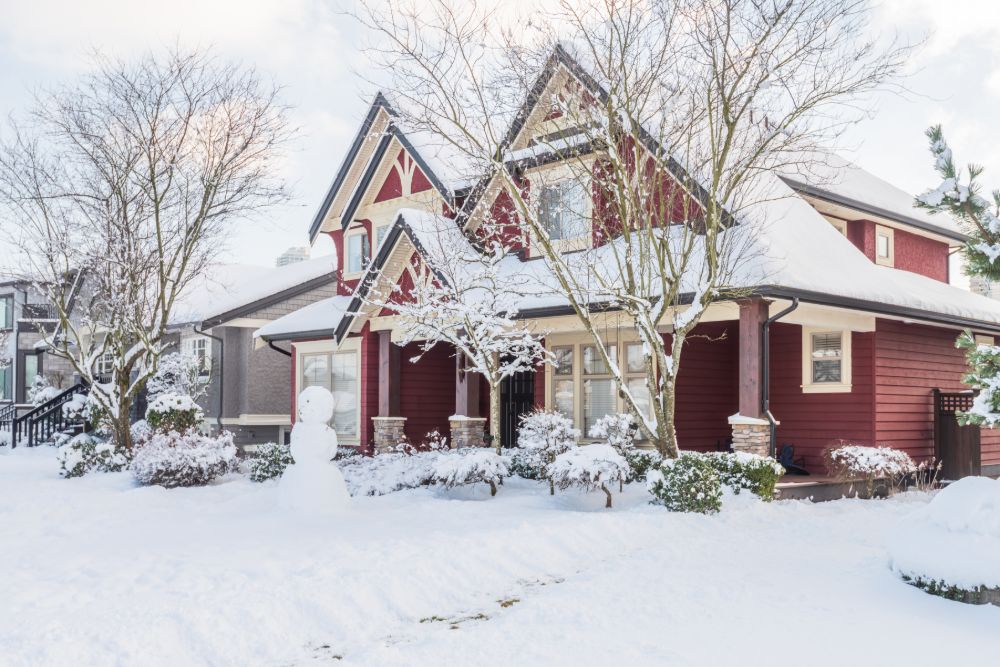The winter months bring many joys including snowfall, holidays, and fun festivities, but they can also take a toll on your wonderful home. Prevent future headaches and damage to your home by following this checklist for winter home maintenance. Here are some of the best ways you could prepare for winter issues such as frozen pipes, blackouts, and ice dams.
Watching Trees that Surround Your Home
Trees are a beneficial part of your home landscaping, but they can create problems in the winter. With the build-up of ice and snow, branches can snap and break – creating big problems. Since no-one wants to deal with blocked driveways, damaged fences and roofs, and big clean-ups, visually inspect your trees in the winter
After leaves have dropped, look for indicators of dead or damaged tree limbs, noting any spots that will require trimming or removal. Avoid issues with heavy snow by brushing – not shaking – heavy snow from limbs and branches with a broom. Pay careful attention to those that extend over your home, driveway, or fences. And, while you’re taking care of your trees, don’t forget to add some ice melt or sand to your sidewalks and driveway!
While removing snow from trees can help prevent limbs from breaking, don’t delay the inevitable – call a professional tree service to deal with removal.
Checking for Ice Dams
Ice dams can lead to major, permanent damage as they lurk on the edges of your roof. They’re created because your roof stays colder than the rest of your insulated home. As snow melts, a wall of ice builds around the eaves. However, this ice dam holds everything back, as melting snow collects above it. Picture a puddle on your roof, looking for the easiest way down. Unfortunately, that may be directly through your roof! Wood damage, mold, mildew, and rot can easily set in.
Get ahead of this potential problem before snowy winter storms arrive. By adding extra attic insulation, keeping gutters clean and free-flowing, and brushing off excess snow loads on your roof with a roof rake, (one item that you may not have thought to add to your new homeowner shopping list) you can prevent ice dams and avoid expensive repairs. You may also wish to use heat cables to help reduce the amount of ice on your roof.
Keep it Warm— Avoid Drafts
Drafty doors and windows are a surefire way to make your winters unpleasant! In addition to unsettling chilly air in your otherwise cozy room, drafts also pull out your warm air, make your house colder, and drive up your heating bill! If you’re feeling cool breezes in the wrong season, it’s time to grab your tool kit and start inspecting the doors and windows in your home. Your mission? Stop the leaks! This is one homeowner tip you’ll be glad to implement.
Check for any cracks or gaps in the caulking or weather stripping around your doors and windows. Reseal any problem areas with new caulking and silicone seal. Don’t forget to check the bottom of doors, too – adding a new, more tightly fitting door sweep can make a huge difference in how cold your floors feel. For quick fixes that will hold you over until you can make more permanent repairs, door snakes and easy-to-use window film will help keep the cold from creeping in and increase your overall energy efficiency. You’ll also appreciate your due diligence if there are power outages!
Cleaning the Fireplace and Chimney
Cold weather means fireplace season! Get ready for those relaxing times in front of crackling logs by taking care of seasonal cleanup duties and adding fireplace care to your maintenance checklist. A professional chimney sweep service is one way to handle this chore, but you can save time by identifying any problems in advance.
As part of a thorough examination of your fireplace, you’ll want to clean any bird nests that could have appeared during the summer, operate the flue damper to ensure that it’s working smoothly, and inspect the firebrick for any issues such as soot buildup or cracking. Always be aware of anything that could create a fire hazard. Even for a clean chimney, it’s best to ensure that it’s drawing properly before you start the first fire of the season.
A clean and properly functioning fireplace will help prevent a smoky house, cold air leaks, and potential fires from soot and creosote build-up. Don’t neglect this item!
Avoid Frozen Pipes
If the mention of frozen pipes sends a chill down your spine, you’re not alone. Bursting pipes occur when water freezes and expands inside them. Ice blocks the pipe, pressure builds up, and a lot of water damage can occur when things thaw. While you’re waiting for the warm-up, you’re also prevented from using any taps, fixtures, or appliances that the pipe supplies.
Prevention is the answer! Ensure that pipes aren’t exposed to freezing temperatures by adding pipe sleeve insulation, sealing cracks in your crawlspace, walls, basement, or attic, and keeping exterior faucets drained or covered in freezing temps. While you’re inspecting your home for any problems, make sure you know the location of your main water shut-off valve, and check on your sump pump’s operation. One easy way to prevent problems and keep pipes from freezing? Keep the heat set no lower than 55 degrees Fahrenheit when you’re out of your home/
If despite your preparation, a pipe does freeze, all is not lost. Leave your faucets open, direct warm air towards the problem area, and check the other faucets in your home. Open up any cabinets around affected pipes to allow the room heat to warm the space, or aim a blow dryer or space heater towards it. If you definitely have a burst pipe, turn off the water supply and contact a plumber. Be sure to prepare for melting ice from the broken pipe as it thaws.
Check your Heating System
It seems strange to check out your heating system in the off season, but it’s one of the best ways to ensure that your home stays comfortable in the fall and winter. No matter what your type of heat, it’s important to perform basic maintenance and cleaning year-round.
Throughout the year, regular replacement of your furnace filter is a quick, easy way to reduce dust and particles in the air and ensure optimal functioning of your system. Although the frequency depends on your specific homelife, a monthly change is a good place to start. Cleaning and clearing exterior and interior vents should be a regular duty, to ensure airflow in either direction isn’t blocked. Consult your owner’s manual for a recommended cleaning schedule of your furnace – a general guide is every three years or so for a gas system.

